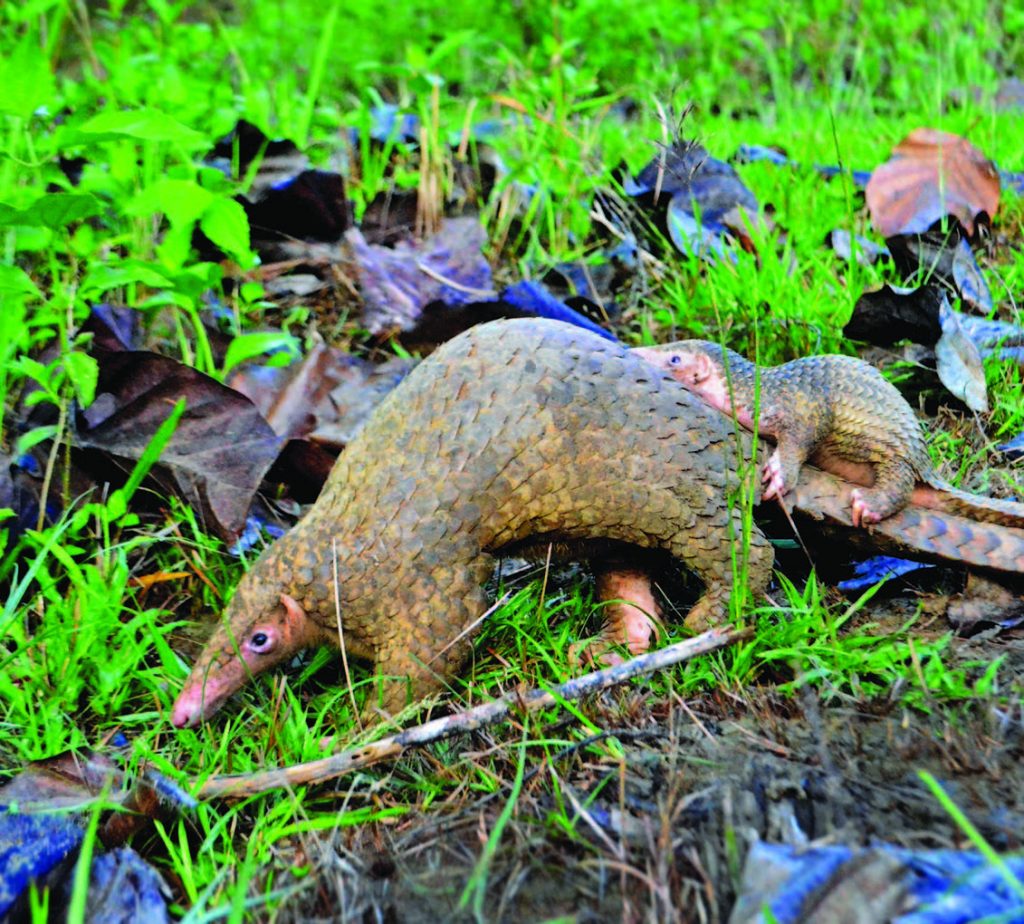Armed with fearsome claws, tough golden scales, and long sticky tongues, pangolins look a bit like baby dragons. Yet these gentle, harmless mammals are caught and killed by the thousands. Dubbed as the most illegally-trafficked mammals on Earth, they’ve become global icons of how animals face extinction via illegal wildlife trade.

Did you know?
Pangolins got their name from the Malaysians, who called them penggulung (parang gulong) for their tendency to roll into protective balls when threatened.
A peek at pangolins
Pangolins’ protective scales shield them from both predators and prey while their tongues help them slurp up to 20,000 ants or termites nightly.
Four species inhabit Africa: the giant ground pangolin, white-bellied pangolin, black-bellied pangolin and Temminck’s ground pangolin. Four more live in Asia: the Sunda pangolin, Chinese pangolin, Indian pangolin and Philippine pangolin (Manis culionensis), found only in Palawan and classified as endangered by the IUCN.

Philippine pangolins spend most days hiding in earthen burrows, rotting stumps or high in trees, emerging only at night to forage for insects. They give birth to one or two young yearly – less than the current rate of capture for the illegal wildlife trade.
Facing extinction
I recently joined an expedition to see them. USAID’s Protect Wildlife Project is working closely with the Palawan Council for Sustainable Development and Katala Foundation to assess pangolin numbers in mainland Palawan. It is funding a dozen ground surveys, each covering 200 hectares of the densest terrain imaginable. Thirty five camera traps to catalogue wildlife have been deployed.

“This initiative aims to give decision-makers an idea of just how many pangolins remain in the Philippines,” explains Dr. Sabine Schoppe, an expert on the Philippine pangolin. “With their range limited to the islands of Palawan, we need to conserve these animals before they’re hunted to extinction.”
TRAFFIC estimates that around a million pangolins have been traded in at least 67 countries over the past decade to feed the centuries-old demand for meat and scales – especially in China and Vietnam, the top consumers. Pangolin meat is a delicacy, while their scales are used as traditional medicine.
Death by human greed
“The traditional Chinese medicine trade has already wrought havoc on Asian pangolin populations, so the trade has shifted to Africa. Since Asian pangolins are now rarer, they fetch higher prices,” adds Dr. Schoppe. The volume by which these strange-looking, harmless mammals are captured belies belief.
At least 667 Philippine pangolins have been apprehended by authorities from 2001 to 2017. In April 2013, a Chinese poaching vessel rammed into the Philippines’ famed Tubbataha Reefs. Found aboard were 2870 dead Sunda pangolins collected from all over Southeast Asia.

In April 2019, 25 tons of scales from an estimated 38,000 African pangolins were confiscated in Singapore, the largest haul ever recorded.
In January 2019, just four months before, nine tons of scales from an estimated 14,000 pangolins were intercepted in Hongkong. From 2007 to 2009, Malaysia’s Sabah Wildlife Department (SWD) revealed how just one syndicate traded 22,200 dead and dressed pangolins. In June 2019, 10 live Philippine pangolins were seized at a checkpoint in Tagaytay City. Seven died while three survived and were brought back to Palawan.
The list of apprehensions go on, even while all pangolin species are prohibited from international trade under CITES.
The belief that pangolin scales – in reality made of keratin (the same material as your hair and nails) – has magical powers, dates back centuries. Traditional Chinese healers believe the scales, which are dried, ground and inserted into pills, relieve fever, pain, ulcers, arthritis and other ailments.
Though these claims have absolutely zero basis in science, convincing millions of customers to shift to alternatives hasn’t proven easy.
“Think about it – no one pays for powdered fingernails, but traditional Chinese medicine believers spend a fortune for powdered pangolin scales, which are no different,” adds Dr. Schoppe. “Legal prescribed medicines are cheaper and more efficient alternatives, while the alleged powers of pangolin scales will die out with the last pangolin. It’s time to leave old traditions behind and opt for more sustainable solutions.”
Aside from western medicine, Chinese medicine experts have found that cowherb seeds, earthworms and other items are viable alternatives to pangolin scales. It’s high time to switch to alternatives before the world’s pangolins forever disappear. (The Wild Side)
Almost gone
Due largely to poaching, the Philippine pangolin population has plummeted as much as 95% since the 1980s. Chinese pangolin numbers have similarly dropped by 94% since the 1960s, while Sunda pangolin populations have crashed by 80% since the year 2000.
This appeared in Animal Scene magazine’s September 2019 issue.
Related stories:
– Protecting the pangolin: Why the only scaly mammal in the world is almost extinct
– The Palawan pangolin
– ‘Dehydrated and weak’ pangolins found hidden on bus in Vietnam






